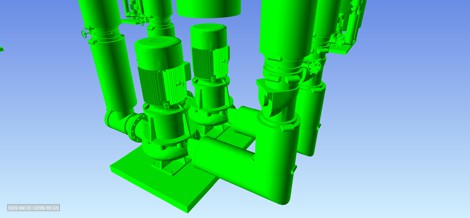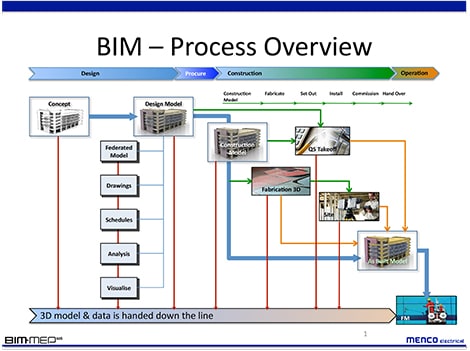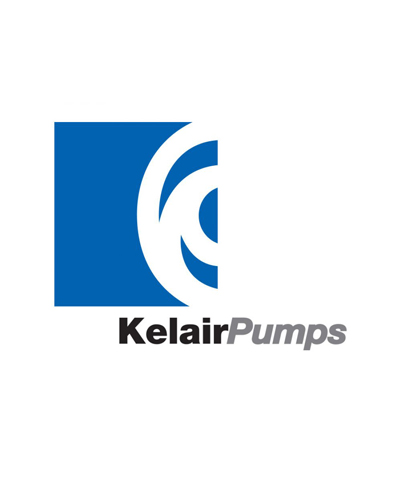By Warwick Stannus, Group Engineering Manager, A.G. Coombs Advisory Pty Ltd. [email protected]
Whilst the Australian Construction Industry had been slow to adopt Building Information Modelling (BIM), it is now recognised globally to be at the leading edge in many aspects of BIM construction modelling and supply chain integration.
A significant contributor to this transformation has been the Air Conditioning and Mechanical Contractors’ Association (AMCA) BIM-MEPAUS initiative and the work done by the Pump Industry Australia that developed their first plant specification.
Building information modelling
Over the last few years, Building Information Modelling has become established as the key design and construction platform for most large projects in Australia and is now rapidly transforming the way projects are delivered and transitioned to long term operation.
One of the key aims with BIM is to complete the virtual build using building information modelling to complete design analysis, spatial coordination and scheduling before commencing the actual build on site. This has allowed increasing utilisation of prefabrication as well as improving scheduling, site safety and productivity.
Building Information Modelling is often confused with 3D CAD, however it is the data that provides the real leverage and extends its value significantly beyond 3D coordination. It is the data that allows the model to be leveraged for a whole variety of value adding purposes. These include system flow and pressure loss analysis and can extend to include checks on working pressures, pipework expansion, pipe stress analysis and anchoring.
One of the key differentiators in Australia’s approach to BIM is the general industry adoption of a single BIM modelling package, Autodesk® Revit MEP for building services design and construction. Whilst not a mandated requirement, the industry adoption of a single package significantly reduces the complexity involved in BIM workflow integration as well as supply chain engagement.
The key concept in BIM-MEPAUS is for a single model to be progressively developed to deliver a Commissioned As Built Model at project completion as illustrated above.
There is still some way to go however with the lessons learnt from the “first generation” of BIM projects now reaching completion. It is likely that the current generation of BIM projects will move much further up the beachhead in terms of realizing the above workflow.
Supply chain integration
Effective Building Modelling is reliant on design and manufacturer’s content to work effectively and it is this that is now the most important factor in the successful industry implementation of BIM.
As part of the supply chain integration strategy, there is a fundamental requirement to replace manufacturer supplied drawings and technical schedules with a certified BIM model.
The challenge is to find an effective and simple means for the supply chain to provide the models required for the virtual design and build process. Whilst modelling is a highly specialized skill, the benchmark now is that the interface to BIM for non BIM modellers should be no more difficult to use than a typical app.
It is generally unrealistic to expect that the supply chain can develop the required models needed to support the workflows as these require considerable expertise in modelling. It is also important that the models be consistent in behavior between the design models and therefore also across suppliers.
The aim of the BIM-MEPAUS initiative was originally to provide a single geometric model and data schedule that:
• Inserts correctly into the project model;
• Was certified dimensionally accurate; and
• Carries the entire data set needed for design, procurement installation and commissioning.
With these integrated data sets, the aim was that the contractor could finalise the design schedules to allow the manufacturer to fully determine the component requirements, finalise a selection and provide a certified manufacturer’s model to the installing contractor. This would then allow the contractor to substitute the design model with a model of the actual pump to be supplied as part of the virtual build.
Pump Industry Australia support
The Pump Industry Australia supported the initiative by facilitating a number of its members to attend BIM-MEPAUS workshops to help define the required schedule needed to accurately specify the pump requirements.
The work was very important and helped develop not only the technical requirements for the pumps but also how future standards would be developed.
New supply chain engagement strategy
Whilst the BIM-MEPAUS initiative has made significant progress over its 3 years, there has been some resetting of the supply chain engagement strategy to accommodate current constraints with respect to scheduling and data handling and to lower the barriers to entry for the supply chain further.
This new strategy comprises a number of key components:
• Development of a National BIM-MEPAUS template add-in which it is hoped will become the standard template for modelling in Autodesk® Revit MEP in Australia used by designers and contractors alike.
• Development of Industry Foundation Models which will be created and managed by Autodesk in conjunction with BIM-MEPAUS.
• A splitting of the schedules associated with each plant item between BIM-MEPAUS Revit Shared Parameters and non Revit Shared Parameters which will be exchanged and managed off model.
The aim is that the Industry Foundation Models will be used by designers as well as manufacturers who can customize them to suit their particular details. Use of these foundation models by designers and manufacturers provides significant benefits:
• It assures interoperability between the manufacturer’s certified model and the system model;
• Reduces barriers to entry for manufacturers; and
• Significantly reduces costs.
Whilst there is significant IP in the pump model, the manufacturer’s IP should be focused and retained in the pump selection software and web interface. The ultimate aim for manufacturers who want to be BIM enabled is to have the industry preferred manufacturer’s website for pump selection and model generation.
Such strategies in other OEM sectors have proven remarkably effective as part of an overall business development strategy.
Design to fabrication and integrated procurement
A.G. Coombs is one of the leaders in BIM services modelling and has been developing its BIM capabilities over the last four years. All projects are now delivered using BIM as their construction platform and pumps and fans are a high priority in terms of integrated procurement.
Their latest project using BIM is a large data centre in Melbourne which is fully modelled in Revit MEP. On this project the consultant’s Revit Design model was used by A.G. Coombs to develop the construction model which is millimetre accurate and has been used for scheduling, procurement, progress tracking and site quality assurance.
A.G. Coombs has been working closely with the supply chain to develop the piping fabrication model to the accuracy required as well as working with individual suppliers to deliver significant shared benefits such as improved scheduling, quality assurance and delivery coordination.
A.G. Coombs’ next goal is to utilise manufacturer’s certified BIM-MEPAUS pumps and fans on its projects to leverage the benefits of the data and workflow. This will provide the project team and client with a number of significant benefits including schedules needed for pump commissioning and life cycle management.
The project points to the future in terms of BIM integrated workflows and supply chain integration and confirms the benefits of both. ■






















